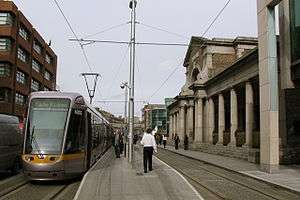Harcourt Street railway station
 The facade of Harcourt Street station | |
| Location |
Dublin Republic of Ireland |
| Coordinates | 53°20′04″N 6°15′46″W / 53.3345°N 6.2629°WCoordinates: 53°20′04″N 6°15′46″W / 53.3345°N 6.2629°W |
| Owned by | CIÉ Railways Division |
| Operated by | CIÉ Railways Division |
| Platforms | 1 |
| Construction | |
| Structure type | At-grade |
| History | |
| Original company | Dublin and South Eastern Railway |
| Pre-grouping | Great Southern Railways |
| Post-grouping | CIÉ Railways Division |
| Key dates | |
| 7 February 1859 | Station opened |
| 31 December 1958 | Station closed |
| 30 June 2004 | Luas Green Line stop opens outside station building |
Harcourt Street railway station is a former railway terminus in Dublin. The station served as the terminus of the line from Dublin to the town of Bray in County Wicklow, although it opened on 7 February 1859 after the initial opening of the railway line itself.[1]
The station facade was designed by George Wilkinson, and contained a central arch and a colonnade of doric columns. The station itself was constructed on an embankment, which led to the platforms being raised and a store in the undercroft for bonded spirits (similar to St Pancras in London).[2]
Although it served as the terminus of the double track section of the Dublin and Wicklow Railway, the station had a single 597 foot long platform on the west side of the railway, which terminated in a 48' diameter turntable, for turning locomotives, at the Hatch Street end of the station. There were two through sidings on the east side of the station, beyond which lay Harcourt Street goods station and the D&WR's locomotive shed. There was no direct access for arriving trains to the goods station, instead 'Up' Freight trains had to pull into the passenger station, then set back on to the 'Down' line before entering the goods station. This was a contributory factor to the well known 1900 train crash. The first signal box was installed in 1878, and was replaced with an electro-mechanical installation in 1938 at which point the station was re-signalled with colour light signals
The station is perhaps most famous for a train crash in 1900 - a goods train from Enniscorthy failed to stop and crashed through the end wall of the station onto Hatch Street, with the locomotive left dangling in mid-air. Following the accident the Railway Inspectorate recommended the installation of a facing junction allow direct access to the goods line, and that until that took place all trains were to stop at Ranelagh to ensure that they made a controlled approach to Harcourt Street station.[3]
After the formation of Great Southern Railways in 1925, Harcourt Street gradually declined in importance as services to the South East were increasingly concentrated on Westland Row (now Pearse) station. Most goods facilities were withdrawn in 1925, when the GSR decided to concentrate goods traffic on the east side of Dublin on North Wall good station. Thereafter, apart from during the 1933 GNR(I) strike, Harcourt Street became predominately a passenger station. The station continued operating until 31 December 1958, when Córas Iompair Éireann, during its rationalisation programme of the railway network, closed the line from Harcourt Street. However, the trackbed was maintained in case of future use of the alignment. Although Harcourt Street is no longer used for heavy rail, the Luas light rail network that opened on 30 June 2004 utilised the route, with a new stop opened in front of the old station. The station building has been converted into a leisure venue with bars and music venues.[4]
Gallery
 The Harcourt Street train crash, 1900
The Harcourt Street train crash, 1900 Harcourt Luas stop
Harcourt Luas stop
See also
| Preceding station | Luas | Following station | ||
|---|---|---|---|---|
| St Stephen's Green | Green Line | Charlemont towards Bride's Glen | ||
| Disused railways | ||||
| Terminus | Dublin and South Eastern Railway Dublin-Bray |
Ranelagh & Rathmines | ||
References
- ↑ Harcourt Street - eiretrains.com
- ↑ Harcourt Street station - Archiseek
- ↑ News, Number 32, Summer 2008, National Library of Ireland
- ↑ The POD